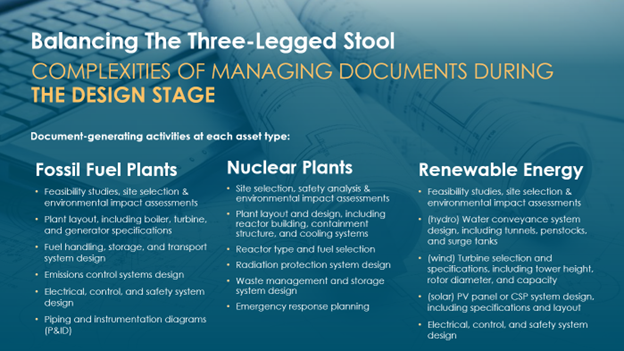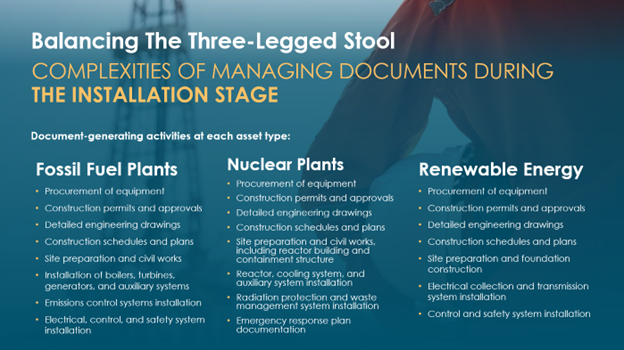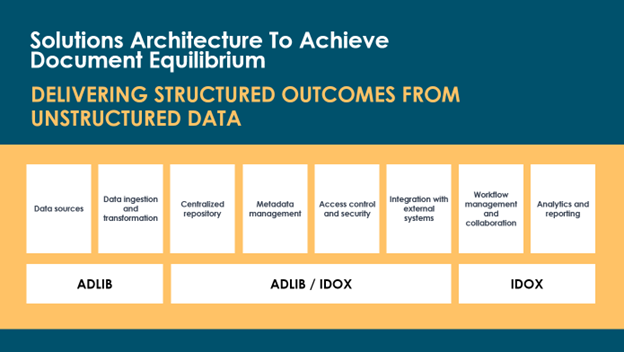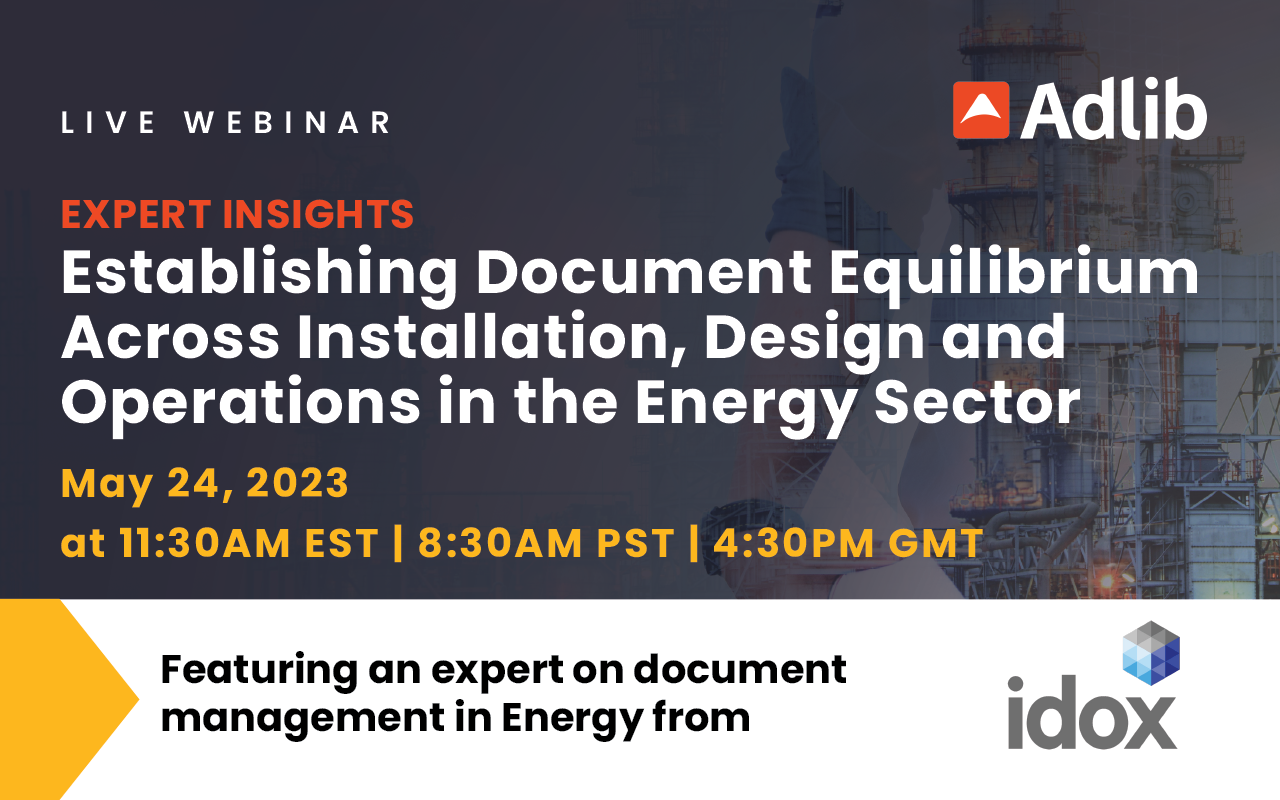Achieving Document Equilibrium across Design, Installation, and Operations Stages in Energy
In the rapidly evolving energy sector, the journey from a mere blueprint to fully operational energy systems involves complex processes that are woven together in various stages - Design, Installation, and Operations. Or as it became colloquially known – The Three-Legged Stool – named so because of the interdependency of data and documentation between the 3, where if technical specifications, regulatory compliance files, installation guidelines, operational procedures and other documentation is mismanaged in one of the stages, it can bring down a world of regulatory and operational pain across all 3.
An oft-overlooked aspect of this documentation process is achieving a state of 'document equilibrium'. Document equilibrium is a state wherein all necessary information is appropriately captured, updated, and made accessible across all stages. This seamless transition and synchronization of information not only ensure the smooth functioning of processes but also serves as a reliable source of record and reference for all stakeholders involved.
In our recent webinar featuring Tim Fleet, a document management expert in the energy sector from Idox, and Colin Wilson, our very own technical document expert, we took a dive into the concept of document equilibrium and its practical application across these three key stages in the energy sector. In our discussion, we shed light on the importance of efficient document management, its challenges, and strategies for achieving document equilibrium.
Watch the on-demand webinar here.
Understanding Document Equilibrium
Document equilibrium in Energy ensures that crucial information about the design specifications, installation procedures, and operational guidelines is available to all stakeholders when they need it. This not only streamlines the overall process but also minimizes potential errors and miscommunications that could lead to costly mistakes or even accidents.
One of the primary hurdles is the sheer volume of documentation involved in each stage of the process. Ensuring that each document is accurately recorded, regularly updated, and readily accessible can be a daunting task, particularly for large-scale projects. Moreover, given the dynamic nature of the sector, with constant technological advancements and evolving regulatory requirements, maintaining document equilibrium becomes even more challenging.
Document Management in the Design Stage
Proper document management at this stage is essential for a myriad of reasons. For one, documents produced during the design stage form the bedrock upon which the entire project is built. They encompass technical specifications, regulations, safety protocols, and preliminary environmental impact assessments, among other things. These documents guide the work of various teams and professionals involved in the later stages of the project.

Here is an excerpt from our recent webinar, outlining specific challenges with managing CAD/CAM design drawings at the Design Stage.
Colin Wilson, Technical Document Expert, Adlib Software:
CAD/CAM is a very interesting file format in itself. Typically, you need specific viewers to be able to view them, and you need to pass these documents around during the design stage, sharing them not only with the people within your organization, but also outside your organization. And they don’t always have that viewing software available.
One of the complexities is to take all the different formats, in this example we’re talking CAD/CAM, and being able to distribute that right across all the people at the various different stages. Being able to create a distributable version of the drawing is very key. One of the advantages of Adlib is to take a CAD/CAM drawing and convert it into a PDF format. But not only that! Within CAD/CAM drawings you have multiple layers and elements you can turn on and off, and to allow you to drill down into different aspects of the drawing. To be able to pass that around and share it with people, you really need to maintain those layers and the capability to switch them on and off.
And that’s what the Adlib solution can do – is to be able to create a PDF with those layers and allow the person who is viewing it to turn the layers on and off.
Another set of complexities is to be able to stamp the document and to move it through the different stages of the Design stage. For example, by adding a stamp that communicates if the drawing is from early on in the process or mid way, to be able to capture which gate it has already gone through. Being able to add that to the drawing is a key requirement, but may not be easy to achieve in the format that you require.
Achieving document equilibrium at the design stage begins with a robust document management system (DMS), such as Idox. This system should be able to handle the multitude of documents generated and ensure they are correctly organized, accessible, and secure within a predefined industry-specific framework.
It is critical to have a well-defined process for document review and approval, such as document date-stamping and watermarking at each approval stage (scroll down to learn how Adlib automates this process). This process helps ensure that all documents are accurate and complete before moving on to the next stage.
Lastly, it's crucial to establish a routine for regular backups of the document repository. This prevents any loss of critical data due to unforeseen circumstances, such as system failures or cyber attacks.
Document Management in the Installation Stage
During this phase, energy systems start to take shape from the theoretical plans laid out in the design stage. The installation stage is typically a hub of activity involving multiple teams, including engineers, contractors, and safety personnel, all of whom rely heavily on the accuracy and accessibility of documents to perform their tasks efficiently.

Tim Fleet, document management expert from Idox, on the importance of accurate documentation translation from design to installation stage:
So what happens here, is we are taking the output from design and putting into a suitable format for one or more construction companies and contractors to use – into what we call Work Packs. The accuracy of this information is paramount. A lot of preparation work is required to present the information in the right format to the people performing the work.
Colin Wilson, technical document expert, Adlib Software:
The creation of construction Work Packs is key. Potentially, they not only contain the drawing, but also may contain output from Word document, spreadsheets, photographs, all sorts of documents that need to be combined into a work pack. The ability to merge different document types into a single distributable document in a format that allows people to consume it out in the field is very key.
Also the ability to take documents, like scanned images or photographs, back from the field and bring them into the system/workflow is key. Being able to consume pretty much any file type but standardize them so you can distribute them and store them is one of the complexities we see at this stage.
Maintaining document equilibrium during the installation stage requires careful planning, constant monitoring, and meticulous documentation. Documentation at this stage includes detailed installation guides, equipment specifications, safety manuals, and regulatory compliance documents. Proper document management during this phase ensures the correct and safe installation of systems, minimizes potential errors, and fosters a culture of accountability and safety.
The installation stage also often requires the need for ongoing modifications and revisions to documents as unforeseen issues or changes arise. An efficient system for documenting these changes is essential to maintaining document equilibrium. This could include clearly dated version controls, documented approval of changes, and systematic distribution to all involved parties.
Document Management in the Operations Stage
The operations stage in the energy sector involves the active use of the systems installed, and it's here that the document equilibrium can truly manifest its long-term benefits. During this phase, an energy system’s performance is tracked, managed, and optimized to ensure it continues to function effectively and efficiently. A range of documents are crucial at this stage, including operating procedures, maintenance schedules, safety protocols, and performance logs.

Maintaining document equilibrium in the operations stage requires a continued commitment to proper document management practices implemented in the earlier stages, with some additional unique considerations.
The primary step is to ensure that all operational procedures are clearly documented and accessible to all relevant parties.
Secondly, operational logs need to be maintained accurately and diligently. These logs, which record system performance and maintenance activities, are crucial for troubleshooting, predicting future performance, and making data-driven decisions.
Tim Fleet, on the ever-changing regulatory requirements impacting operations documentation:
I think it is most important for an asset owner to ensure that the drawings and documents that are leveraged by different personnel within an asset are accurate and up to date. The challenge here is that there isn’t a steady state with regards to documentation in a plant. There is always some external influence. There is always a change in equilibrium.
For example, a regulator may change some requirements on the plant, which means a change to the design, which means some change to the plant, which means update operational documentation. The challenge is ensuring the flow and coordination from end to end. Unfortunately, in many cases, plant level changes that take place may never get reflected in the design or operational documentation.
Another complication is that often a change to a single area of the plant means you are concurrently making changes to multiple sets of documents and drawings.
Colin Wilson, technical document expert, Adlib Software:
Regulatory bodies often have a very specific requirement around the format of the submissions. Being able to merge documents from disparate data sources and disparate file types together, and to produce a cohesive document with a correct table of contents, hyperlinks or color of hyperlinks inserted, is very key.
But also being able to create documents of record, and be able to archive them with a level of security. For example, it is very important to be able to create a PDF in a very specific format, such as PDF/A for long-term archival, or a regulator may require a PDF 1.5/1.6 format.
Finally, just like in the previous stages, regular audits and clear communication remain vital in this stage as well. Regular audits ensure that all documents are up to date and compliant with regulatory requirements. Clear communication, particularly about changes to operational procedures or safety protocols, ensures everyone is aware of their roles and responsibilities.
A Solution Architecture To Achieve Document Equilibrium
Idox and Adlib can greatly assist energy organizations in achieving document equilibrium - a state where all documents are easily accessible, managed, and utilized for maximum operational efficiency.

Here's how:
Idox
Idox is a suite of solutions designed to manage, control, and share the vast amount of information that organizations generate and use on a daily basis. The solution is particularly focused on the needs of large public and private sector organizations and offers a comprehensive approach to managing the entire lifecycle of documents, records, and other information.
- Data Management and Compliance: Idox's Enterprise Information Management (EIM) system aids energy organizations in managing vast amounts of data efficiently. This includes storage, retrieval, and manipulation of data to meet the operational, regulatory, and compliance requirements of energy organizations.
- Workflow Automation: With Idox, energy firms can automate various document-related tasks, reducing manual effort, improving accuracy, and speeding up document processing times.
- Improved Collaboration and Information Sharing: Idox promotes seamless collaboration and information sharing across different teams and departments. This can lead to better decision-making and problem-solving.
- Cloud-Based Access: With Idox's cloud-based solutions, energy companies can access critical documents from anywhere, which is particularly important in the field-heavy energy sector.
Adlib
Adlib is an industry-leading document transformation solution that creates 100% machine-readable and searchable, compliant, audit and archive-ready, secure documents of record, revolutionizing the management of unstructured data across highly regulated industries, such as oil, gas & energy.
- Document Ingestion: Adlib supports 300+ file types and native connectivity to major Enterprise Content Management Systems, helping energy organizations automate labor-intensive document processing workflows, saving valuable time and effort.
- Auto-creation of Documents of Record: Adlib auto-generates auditable, searchable and machine-readable Documents of Record by merging and organizing, date-stamping, adding custom headers and footers, generating a dynamic table of contents and watermarking various document types, helping organizations ensure compliant document security, archival and audit procedures.
- Improved Search and Retrieval: Adlib's solutions enable quicker, more accurate search and retrieval of documents across systems. This supports effective data exchange and collaboration between different platforms, facilitating document equilibrium.
- Quality Assurance and Compliance: Adlib's software helps identify errors, inconsistencies, and missing information, thereby improving data quality. This supports seamless data exchange, interoperability between systems, and compliance with industry regulations.
By effectively managing and streamlining document processing and management, both Idox and Adlib can help energy organizations achieve document equilibrium, resulting in improved efficiency, compliance, and decision-making.
Colin Wilson, technical document expert from Adlib Software, on interoperability:
Having everything work together seamlessly is key. Being able to integrate multiple independent systems can be very challenging. The way we interoperate is via a push or a pull model. We have the ability to create “connectors” that will connect to data sources so we can pull data directly from a data source and pass it into a tool, such as Idox. Or we also have Web Services API, that allows data to be passed to and from.
Conclusion
The energy sector is characterized by complexity and dynamism. As such, maintaining document equilibrium is not merely about achieving operational efficiency; it also plays a pivotal role in ensuring safety, regulatory compliance, and overall project success.
While achieving document equilibrium may seem daunting given the sheer volume and complexity of documents involved, the case study mentioned in this blog demonstrates that it's indeed achievable. By prioritizing document equilibrium, energy companies can streamline processes, enhance collaboration, reduce errors, and ultimately drive better project outcomes.
Our history at Adlib has been all about managing unstructured data into Documents of Record, and working with our partners, such as Idox, to make sure that we integrate with their application infrastructure. Our next iteration is leveraging AI and Machine Learning to automatically classify these Documents of Record against an industry-specific schema and to extract Critical Data Elements. In each of these cases we are keen to explore these conversations with our customers and partners.
- Harry Chopra, Chief Client Officer, Adlib Software
Watch the full webinar for more information, or request a call back from one of our experts to learn more about how to streamline document management in your organization with Idox and Adlib.





